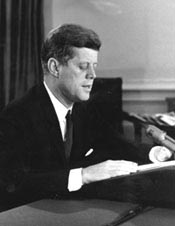September & October 2002 Feature
The Cuban Missile Crisis: October 1962
 |
In a televised address on October 22, 1962, President Kennedy informed the American people of the presence of missile sites in Cuba. (Kennedy Library) |
Forty years have passed since the hottest moment of the Cold War—the Cuban missile crisis.
U.S. forces around the world were placed on alert. More than 100,000 troops deployed to Florida for a possible invasion of Cuba. Additional naval vessels were ordered to the Caribbean. B-52s loaded with nuclear weapons were in the air at all times.
The United States had caught the Soviet Union building offensive nuclear missile bases in Cuba, just 90 miles from US soil, and the two superpowers were now joined in the first direct nuclear confrontation in history.
Reconnaissance flights over Cuba had begun in the summer of 1962, and surveillance photographs taken on October 14 showed the beginnings of a Soviet medium-range ballistic missile base near San Cristobal. Two days later, the President called together his most trusted advisers to serve as an Executive Committee of the National Security Council (ExComm). They discussed several courses-everything from doing nothing to invading Cuba. After much debate, a naval blockade of the island emerged as the leading choice.
In a televised address on October 22, 1962, President John F. Kennedy informed the people of the United States of the Soviet missiles and of the "quarantine" placed around Cuba by the US Navy.
Tensions mounted over the next few days as the world wondered if there could be a peaceful resolution to the crisis. On October 24 several Soviet vessels turned back from the quarantine line, though construction at the missile sites continued. Soviet Premier Nikita Khrushchev wrote a long letter to the President on October 26 proposing a settlement. He declared that ships bound for Cuba did not carry armaments and added that if the blockade were lifted and the President gave assurances that the United States would not invade Cuba, the missile sites would be removed.
The next day, in a response to Khrushchev, Kennedy called the proposals "generally acceptable as I understand them." On October 28 the Soviets agreed to dismantle and withdraw the missiles from Cuba. Negotiations for final settlement of the crisis continued for several days, but the immediate threat of nuclear war had been averted.
On November 20 Kennedy announced, "I have today been informed by Chairman Khrushchev that all of the IL-28 bombers in Cuba will be withdrawn in thirty days. . . . I have this afternoon instructed the Secretary of Defense to lift our naval quarantine." Subsequently, the United States dismantled several of its obsolete air and missile bases in Turkey.
The Cuban missile crisis was perhaps the greatest test of John F. Kennedy's Presidency, and while he and Khrushchev were able to achieve a peaceful resolution, the crisis had a number of far-reaching historical consequences. Within a year, Kennedy and Khrushchev signed the Nuclear Test Ban Treaty, the first disarmament agreement of the nuclear age. Also in 1963, the first "hotline" between Washington and Moscow was installed.
To observe the 40th anniversary of Cuban missile crisis, the John F. Kennedy Library in Boston is presenting a series of forums and a special exhibit featuring original artifacts and images associated with the 13 days of the crisis. Highlights of the exhibit will include the first aerial reconnaissance photo of missile sights under construction; the original copy of Proclamation 3504 (on loan to the Kennedy Library from the National Archives in Washington, DC), authorizing the naval blockade of Cuba; handwritten memos, notes, and doodles created by President Kennedy during ExComm meetings; and correspondence exchanged between the President and Khrushchev.
A short film on the crisis, shown exclusively at the Kennedy Library, incorporates period news footage, interviews with President Kennedy, and tape-recorded excerpts from the top-secret meetings between the President and his advisers. The exhibit opens October 1, 2002, and runs through May 15, 2003.
The forum series, "On the Brink: The Cuban Missile Crisis and the Nuclear Threat," features prominent historians, policy makers, and journalists. The panelists include former Kennedy administration officials, such as Theodore Sorensen, Robert McNamara, and Arthur Schlesinger; Khrushchev's son; and Dagoberto Rogriguez, chief of the Cuban Interests Section in the United States. They will discuss the crisis itself and examine some of the current issues, such as U.S.-Cuba relations and the proliferation of weapons of mass destruction, that challenge us today. The first forum is on October 1, and the full schedule of times and speakers is available on the John Fitzgerald Kennedy Library and Museum web site: www.jfklibrary.org.
The John F. Kennedy Library is part of the nationwide Presidential library system administered by the National Archives and Records Administration.
PDF files require the free Adobe Reader.
More information on Adobe Acrobat PDF files is available on our Accessibility page.
